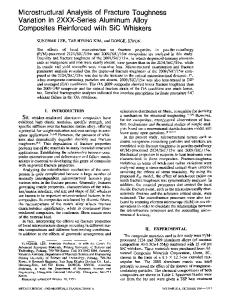Work of fracture in aluminum metal-matrix composites
- PDF / 3,394,698 Bytes
- 9 Pages / 594 x 774 pts Page_size
- 51 Downloads / 421 Views
I.
INTRODUCTION
T H E mechanical properties of metal-matrix composites are governed by a complex interaction of factors related to the individual component properties. The nature and role of the interface between the constituents in various types of composites have been widely discussed in the literature. Generally, the formation of interfacial reaction products reduces the interface strength, which can modify crack initiation and propagation behavior. The stress transfer between fiber and matrix is also affected, and frequently this results in a decrease in strength and ductility. Interfacial degradation can occur in metal-matrix composites during fabrication and on subsequent isothermal exposure or thermal cycling during elevated temperature service. In B/A1 composites, postfabrication elevated temperature exposure has been shown to degrade ambient temperature strength) The effect was accelerated with a combination of cyclic loading and elevated temperature exposure) Thermal cycling alone has also been shown to decrease the strength and modulus of B/A1 composites.2'3 White and Wright 4 observed a greater decrease in both longitudinal and transverse strength in B/A1 cycled in air than in argon. Kim et al 5 found that the interfacial reaction products that formed during isothermal elevated temperature exposure of B/AI were the same in argon and air. White and Wright examined the effect of thermal cycling on the strength integrity of B/A1 composites having an alloy matrix of 1100, 2024, and' 6064 aluminum alloy, respectively.4 Matrix composition did ,affect the response; B/A1 (2024) and B/A1 (6061) were more susceptible to strength degradation than B/A1 (1100). In contrast, Grimes et al 3 have reported a more rapid decrease in the tensile strength of B/A1 (1100) than of B/A1 (6061) as a result of thermal cycling. Boron fibers extracted from composites cycled in air have been found to have a lower strength than those cycled in argon.4 Kim et ai 5 have identified the reaction products on the surface of boron fibers extracted from both B/A1 (1100) and B/A1 (6061) after isothermal exposure at 773 K as A1B2 and AIB~2, respectively. A. SKINNER is Physical Metallurgist with Revere Research, Inc., Edison, NJ 08817. M. J. KOCZAK and A: LAWLEY (the latter currently on leave of absence with Cabot Corporation, Kokomo, IN 46901) are Professors of Materials Engineering, Department of Materials Engineering, Drexel University, Philadelphia, PA 19104. Manuscript submitted August 12, 1980. METALLURGICAL TRANSACTIONS A
The object of this study has been to characterize the toughness response of B/AI composites in the as,fabricated condition and following elevated temperature isothermal exposure or thermal cycling. Comparative tests were also carried out on alumina/A1 composites. Observed changes in toughness have been correlated with and analyzed in terms of associated modifications to the matrix, fiber, and matrixfiber interface.
II.
EXPERIMENTAL PROCEDURE
A. Materials
B/A1 composites in the form of sheet panels 6.25 mm thick wer
Data Loading...











